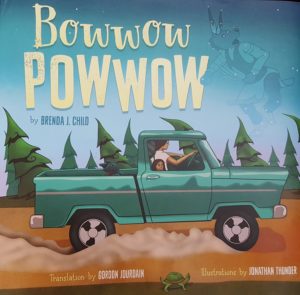Book review: Bowwow Powwow
“Bowwow Powwow” by Brenda J. Child, illustrated by Jonathan Thunder and translated into Ojibwe by Gordon Jourdain tells the story of Windy Girl’s experiences at a powwow and after a long day, her dream about a powwow. This beautiful and engaging book was written for children between the ages of six and seven years old.
This story introduces readers to powwows. They discover what to expect when they attend one and their importance to Indigenous culture. The reader learns some of the history of the dancers and the names of the various dance styles, helping to remove some misunderstandings people may have about powwows. This may encourage more people to attend them, fostering an increased understanding and respect of Indigenous culture. In turn, this could lead to improvements in the relationship between Indigenous and non-Indigenous peoples.
The tone of this story is joyful and gentle while being respectful and solemn when needed. The reader feels Windy Girl’s anticipation as she travels to the powwow and her excitement and joy at being there. This also makes Windy Girl someone readers can relate to, increasing the impact of the story. In addition, the mood helps to illustrate the importance of powwows to Indigenous peoples and the sense of community and pride they promote.
Another element making this story one that children can relate to is the fact that the characters at the powwow in Windy Girl’s dream are dogs. Dogs are popular pets and children often attribute human characteristics to animals, especially their pets. This makes it entirely believable that Windy Girl would have a dream in which dogs act like people, especially given her great affection for her dog Itchy Boy and his behaviour.
The language employed by Ms. Child is that used by the target audience making it understandable and relatable to them, ensuring that they will want to continue reading. In turn, they will learn more about Indigenous culture fueling appreciation and awareness.
Jonathan Thunder’s illustrations are beautiful. They are full of colour and detail and give a visual representation to the emotional quality of the story. They add to the story by enhancing the gentle and joyful tone of the narrative. The reader also gets to see what the regalia of the various dance styles looks like, further enhancing their understanding of what is happening.
Having “Bowwow Powwow” translated into Ojibwe is another factor strengthening this book’s significance. This gives both Indigenous and non-Indigenous people exposure to the Ojibwe language, hopefully creating an interest in learning the language. This serves to keep the Ojibwe language alive in a time when many Indigenous languages are disappearing. This also helps fight shame some residential school survivors may feel in speaking their own language.
This story also pays homage to Indigenous veterans. Windy Girl dreams about veterans marching in the Grand Entry. Too often the contributions and sacrifices of our Indigenous veterans are forgotten or ignored. This part of “Bowwow Powwow” helps to change that by acknowledging what they have done for the country we call Canada.
To anyone looking for a book to teach children about powwows and the different styles of dancing, “Bowwow Powwow” is without hesitation a very powerful teaching tool. It would be an asset to any library.
“Bowwow Powwow” by Brenda J. Child, illustrated by Jonathan Thunder, translated by Gordon Jourdain, Minnesota Historical Society Press, ISBN 978-1-68134-077-7.



